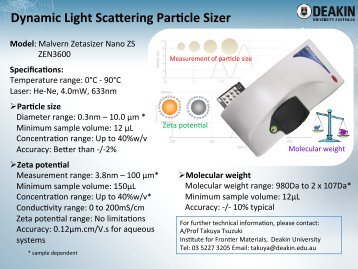

- #Download Software Malvern Zetasizer Software Manual manual
- #Download Software Malvern Zetasizer Software Manual iso
Thus, the nano-bio community is left with insufficient guidelines which lead to serious data analysis and interpretation errors with implications beyond just irreproducibility, especially when the key conclusions of a study are critically dependent on such choices.
#Download Software Malvern Zetasizer Software Manual iso
For instance, the definition of the DLS size in the current ISO 22412 ( 2017) as the “central value of the underlying particle size distribution” is ambiguous, i.e., whether it refers to the mean, median, mode, or other central tendencies. 2018), and documentary standards (ASTM E2490-09: 202: 2017) frequently offer vague, inadequate, or even incorrect guidance. Unfortunately, however, instrument manufacturers (Nobbmann and Morfesis 2009), best practice guides (Nicolas et al. A common dilemma is that the DLS software typically offers several types of central values based on intensity, volume, or number weighting as the output of the measurement (Bhattacharjee 2016).
#Download Software Malvern Zetasizer Software Manual manual
Ambiguities in mean-value terminology are also prevalent in commercial DLS software and documentary standards (Zetasizer nano user manual 2013 ASTM E2490-09: 202: 2017). In current practice, the choice of weighting and means of the size distribution by DLS is often unjustified or appears to be picked ad hoc (Bazylińska 2017 Myerson et al. Despite its overwhelming dominance in nanoparticle characterization, consistency and reproducibility of the DLS measurements remain a significant challenge, mainly because of questionable data analysis and interpretation. In recent years, for instance, more than 50% of drug products containing nanomaterials submitted to the Center for Drug Evaluation and Research within the US Food and Drug Administration relied on DLS for size characterization (D’Mello et al. Dynamic light scattering (DLS) is the method of choice in most cases.

Successful realization of such products is critically dependent on reliable dimensional measurements to correlate nanometer-scale physical-chemical properties with their intended functionality. They substantially enhance the performance of many industrial and research-oriented products. The significance of nanoparticles is apparent and indisputable in a broad range of scientific and technical fields. These results overall are intended to bring essential improvements and to stimulate reexamination of the metrological capabilities and role of DLS in nanoparticle characterization. We also investigate the extent to which the DLS polydispersity descriptors are representative of the distributional quality and find them to be unreliable and misleading, both for monodisperse reference materials and broad-distribution biomedical nanoparticles. We explicitly identify and validate the harmonic mean as the central value of the intensity-weighted DLS size distribution that expresses the inversion results consistently with the cumulant results. The resulting discrepancies are typically larger than 15% depending on the polydispersity index of the samples. Through the measurement of monomodal nanoparticle samples having an extensive range of sizes (5 to 250 nm) and polydispersity, we similarly demonstrate that the default outputs of a frequently used DLS inversion method are ill chosen, as they are regularizer-dependent and significantly deviate from the cumulant z-average size. Central values obtained incautiously from this representation often lead to significant interpretation errors. We address the misleading way DLS size distributions are often presented, that is, as a logarithmically scaled histogram of measured relative quantities. Here, we critically discuss the application of DLS for nanoparticle characterization and provide much-needed clarification for ambiguities in the mean-value practice of commercial DLS software and documentary standards. Dynamic light scattering (DLS) is an essential technique for nanoparticle size analysis and has been employed extensively for decades, but despite its long history and popularity, the choice of weighting and mean of the size distribution often appears to be picked ad hoc to bring the results into agreement with other methods and expectations by any means necessary.


 0 kommentar(er)
0 kommentar(er)
